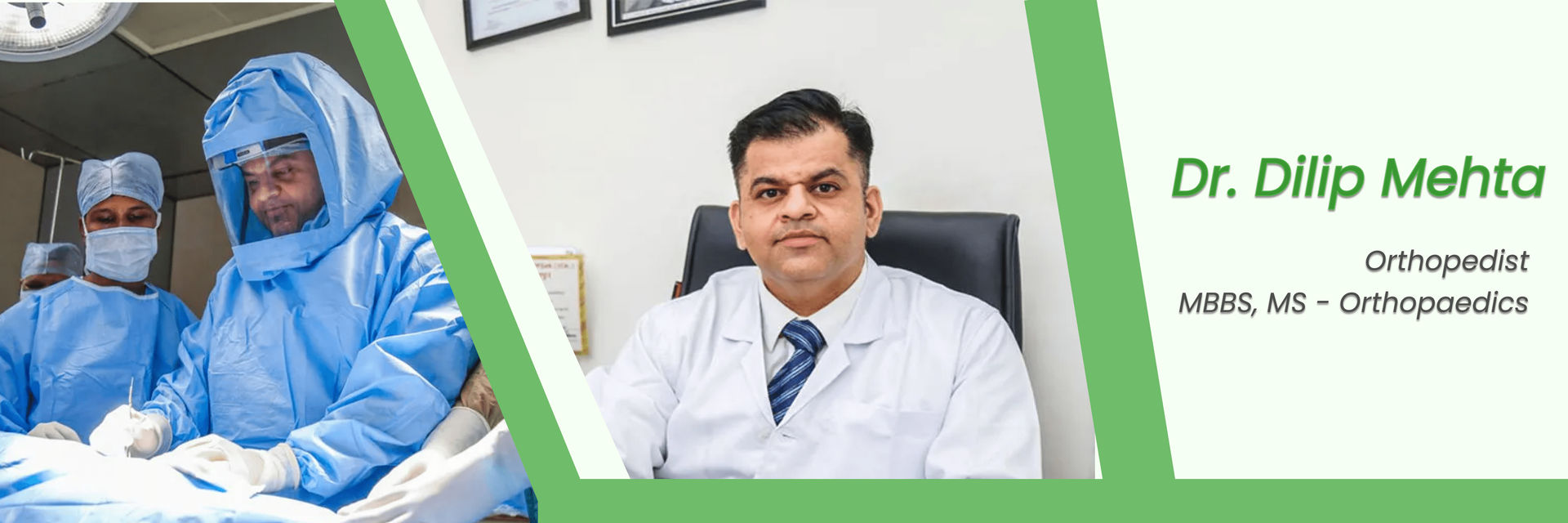What is ACL and Meniscus Surgery?
Meniscus and anterior cruciate ligament surgery are two typical orthopedic procedures used to treat knee injuries and associated conditions.
ACL Surgery:
The anterior cruciate ligament, a vital ligament in the knee that stabilizes the joint while it moves, must be operated on. Due to abrupt twists, pivots, or sports-related injuries, it may rip or rupture. To restore stability and function to the knee, ACL surgery includes rebuilding or repairing the injured ligament using grafts or sutures.
Meniscus surgery:
The meniscus is a cushion-like cartilage in the knee that acts as a support and absorbs shock when the knee moves. Meniscus rips can happen as a result of acute trauma or gradual wear and strain.
To relieve discomfort, increase mobility, and stop further injury to the knee, meniscus surgery involves either mending the torn meniscus or, in rare situations, removing the injured section.
Take the first step to recovery. Get in touch with us for your treatment.
ACL and meniscus procedures are carried out, which include utilizing a tiny camera and specialized tools through tiny incisions. This technique leaves fewer scars and leads to a quicker recovery period than conventional open surgeries. These operations are advised for people who have ligament and meniscus problems that result in persistent knee pain, instability, and restricted function.
To assist patients restore their strength, flexibility, and range of motion in their knees, rehabilitation and physical therapy are essential components of the healing process.
Find out if ACL and meniscus problems can occur at the same time.
Can ACL and meniscus injuries occur simultaneously?
Yes, it is possible for both an ACL and meniscus injury to develop at the same time. This happens during specific traumatic events or accidents involving sports.
ACL and meniscus injuries can occur simultaneously when a person twists or extends their knees. This causes tremendous stress on both structures. For instance, rapid stops, pivots, or changes in direction can put undue pressure on the knee. In sports like soccer, basketball, or skiing, making it prone to such conditions.
ACL tears increase the chance of meniscus tears, although the exact mechanism of injury can differ. When the ACL is torn, the knee can become unstable and the motion of the joint can change. This can increase the pressure on the meniscus along with the risk of rips.
The treatment and healing procedure may become more challenging when an ACL and meniscus are both injured at the same time. The method of therapy will be determined by the nature, extent, and patient's general knee health of the injury. Surgery may be required to replace or reconstruct both the ACL and the meniscus.
To assure the best results and assist patients in regaining strength and function in their knees, rehabilitation and physical therapy are essential parts of the healing process. It's crucial to have a quick diagnosis and rapid treatment for knee problems to stop them from getting worse.
Let’s learn the symptoms of ACL and meniscus damage.
What are the symptoms of ACL and meniscus injuries?
Depending on the extent of the injury and the patient, meniscus and ACL injuries can present with a variety of symptoms. The typical signs and symptoms of each kind of damage are listed below:
Signs of ACL injuries
Signs | Description |
|---|---|
Sudden and Intense Pain | ACL injuries result in sudden, severe knee pain at the time of the injury. |
Swelling | Within a few hours of the accident, the knee may swell. |
Instability | Many people say they experience knee instability or a "giving way" feeling, especially when trying to bear weight or change direction. |
Audible Pop | ACL tear or rupture is indicated by an audible popping sound that some victims report hearing at the time of injury. |
Limited Range of Motion | Pain and swelling make it difficult to extend or bend the knee. |
Symptoms of Meniscus injuries
| Symptoms | Description |
|---|---|
| Swelling | Meniscus injuries can also result in knee joint swelling, much like ACL injuries might. |
| Knee tenderness and pain | The knee may feel painful to the touch, especially along the joint line. |
| Difficulty Extending or Flexing the Knee | Some people may experience difficulty extending or flexing the knee as a result of the torn meniscus becoming lodged in the joint. |
| Sensation of catching or locking | Some people with a meniscus injury may feel as though their knees "catch" or "lock" as they move. When a torn fragment of the meniscus gets wedged between the surfaces of the joint, it causes this sensation and limits knee motion. |
| Instability and giving way | Like an ACL damage, a meniscus injury can make the knee feel unstable and give way, especially while engaging in activities that need quick movements. |
| Joint stiffness | After periods of inactivity or rest, the damaged knee may feel stiff. The stiffness may lessen with movement but may come back if the knee is immobile for an extended period of time. |
Meniscus and ACL injuries are both serious conditions that need to be diagnosed and treated. It's crucial to see a healthcare provider for a complete evaluation if you think you may have hurt your knee.
They will assess the damage and suggest the best course of action, which may include rest, physical therapy, pain medication, and, , surgery to restore the knee's damaged structures. Adhering to the recommended course of therapy is essential for a speedy recovery and the avoidance of long-term problems.
Let’s look into the common causes of ACL and meniscus injuries.
What are the common causes of ACL and meniscus injuries?
Meniscus and ACL (anterior cruciate ligament) injuries happen for a variety of reasons, including:
Running or jumping while changing direction or halting can exert a lot of strain on the ACL, which can cause tears or ruptures.
Landing Wrong:
An incorrect landing after a leap, particularly when the knee is stretched or bent, can harm the ACL.
Twisting or Hyperextension:
The ACL can be harmed by hyperextending or twisting the knee past its natural range of motion.
Sports Injuries:
ACL injuries are more common in high-impact sports like soccer, basketball, football, skiing, and gymnastics because of the quick movements they need.
Non-contact Injuries:
ACL injuries can happen without physical contact, for example, when a sportsperson lands their foot and their knee gives way.
Sudden Twists or Turns:
Meniscus tears can result from sudden, severe twisting of the knee while carrying weight.
Squatting or Deep Knee Flexion:
Deep knee flexion exercises like squats or lifting heavy objects can strain and tear the meniscus.
Direct Impact:
In contact sports, a direct knee strike is common and can harm the meniscus.
Age-related Degeneration:
The meniscus may weaken and become more prone to tears during daily activities as people age.
Pre-existing Knee disorders:
Some people may have menisci that are more prone to tears because of past injuries or degenerative disorders that have weakened them.
The risk of these injuries can be decreased by following a suitable training regimen, donning the necessary safety equipment, and identifying and treating knee discomfort as soon as it arises. If an injury does occur, need to get medical help right once to assess the damage and develop a treatment strategy.
Want to know about the complex details of ACL and meniscus surgery? We have got you covered! Keep reading to find out more.
Your health is too important to ignore – schedule your appointment now.
How is ACL and meniscus surgery performed?
Both meniscus and ACL operations are utilized to repair severe damage to these knee components. Orthopedic physicians with experience in sports medicine and knee injuries perform these operations. An outline of each surgery's procedure is provided below:
Anterior Cruciate Ligament Reconstruction (ACL Surgery):
Preparation and anesthesia:
The patient is made ready for surgery, and general or regional anesthetic is given to make sure they are relaxed and pain-free throughout the process.
Arthroscopy:
Arthroscopic procedures are used in ACL surgery. An arthroscope (a tiny camera) is placed into one of the small incisions made around the knee. The camera enables the surgeon to see a check image of the inside of the knee.
Assessment and graft preparation:
The surgeon evaluates the ACL injury and gets the knee ready for the graft. The patellar tendon, the hamstring tendons, or cadaveric tissue (allograft) can all be used as supplies for the graft. The surgeon's preference, the patient's age, activity level, and other variables all play a role in the transplant selection process.
Graft implantation:
The chosen graft is then positioned in the knee to act as an ACL replacement. Screws or other fixation methods are used to fasten the graft to the bone.
Reconstruction:
To recreate the position and function of the original ACL, the surgeon threads the graft through bone tunnels in the femur and tibia.
Closure:
After the graft has been fixed in place, the surgical tools are taken out and the incisions are stitched or stapled shut.
Surgery on the meniscus (meniscectomy or meniscus repair):
Depending on the location and extent of the meniscus tear, a particular type of meniscus surgery may be required. The two most common meniscus surgeries are:
Meniscectomy:
The surgeon trims and removes the damaged meniscus in this technique. The outside part of the meniscus, where there is a decent blood supply that can aid in healing, is where this procedure is often done when the tear is there.
Meniscus Repair:
The surgeon may decide to do a meniscus repair if the tear is in the inner region of the meniscus, where blood supply is restricted, or if the patient is young and the rip is receptive to repair. The torn edges of the meniscus are stitched together during a meniscus repair, enabling it to heal on its own.
Recovery:
Patients who have had ACL or meniscus surgery go through a rehabilitation program that includes physical therapy to rebuild their knee's strength, flexibility, and stability. The length of recovery depends on the severity of the injury, the type of operation, and personal characteristics.
It takes patients many months to heal before they can resume their normal activities, and it might take up to a year for the knee's function to normalize. To guarantee a satisfactory outcome and avoid complications, patients must adhere to their surgeon's post-operative advice.
Find out how to protect your knees from ACL and meniscus damage.
Can ACL and meniscus injuries be prevented?
It can be difficult to completely avoid ACL and meniscus injuries, particularly in high-impact sports and occupations that need quick changes in direction or pivoting. The likelihood of these injuries can be decreased, though, by following a few tips and precautions:
Strengthening and conditioning:
By focusing on the muscles that surround the knee and hip joints, a well-rounded strength and conditioning program can assist to increase stability and lower the risk of injury. Concentrate on workouts that strengthen the gluteal, hamstring, and quadriceps muscles.
Appropriate Stretching and Warm-Up:
Always warm up before participating in sports or physical activities. Static stretching is less effective than dynamic stretching, which involves moving the muscles through their complete range of motion.
Correct Technique:
To prevent placing excessive stress on the knees, learn and practice suitable techniques for sports and activities. Trainers and coaches can offer direction to guarantee safe mobility.
Wear Protective Gear:
Wearing the proper protective gear might be helpful in sports where knee injuries are more likely to occur. For added support, athletes may, for instance, use knee braces or specific footwear.
Prevent Overtraining:
Allow the body enough time to rest and recover between hard workouts or competitions. Overtraining can result in fatigue and a higher risk of injury.
Change Exercise on Tired or Uneven Surfaces:
Knee injuries are more likely to occur when exercising or playing on fatigued or slick surfaces.
Maintain a Healthy Body Weight:
Carrying around extra pounds might put more strain on the knees. Also to improving general health, maintaining a healthy weight helps lower the chance of knee problems.
Cross-Train:
Taking part in a variety of sports and physical activities will lower the risk of knee overuse problems and assist prevent overuse issues from occurring.
Pay Attention to Your Body:
If you feel knee pain or discomfort, or any other joint problems, pay attention to it and give yourself time to heal. Ignoring pain may result in more serious wounds.
Even with precautions taken, accidents can still happen. Seek medical help as soon as you suspect an ACL or meniscus injury to ensure an accurate diagnosis and effective course of therapy. An injury's impact can be reduced and a patient's recovery can go more with early intervention and proper management.
Discover alternate rehabilitation options for ACL and meniscus injuries with non-surgical treatments!
Are there non-surgical treatment options for ACL and meniscus injuries?
There are non-surgical treatments available for some ACL and meniscus problems. The right course of action will vary depending on the type and extent of the injury as well as personal characteristics like age, amount of activity, and general health. For minor to moderate injuries or in circumstances when surgery is neither possible nor desirable, non-surgical treatments may be taken into account. Here are a few non-surgical possibilities for treatment:
Non-operative care for ACL and meniscus injuries:
Physical Therapy:
Physical therapy is a crucial part of managing ACL damage without surgery. Therapy professionals can create individualized workout plans to tone the muscles around the knee and increase stability. People with partial ACL breaks or those who want to postpone surgery are advised to use this method.
Bracing:
After suffering an ACL injury, wearing a knee brace can help to stabilize and support the knee joint. For people who only need to play a small amount of sports or physical activity, this could be helpful.
Activity Modification:
To prevent further injury to the damaged knee, stay away from sports or high-impact activities that need quick changes in direction.
Rice Therapy:
Rest, Ice, Compression, and Elevation (RICE) therapy can assist to lessen knee swelling and stiffness.
Pain management:
To manage pain and lessen inflammation, anti-inflammatory drugs or over-the-counter painkillers may be utilized.
It is crucial to bear in mind that not all ACL and meniscus injuries can be treated non-surgically, especially if the severity of the damage is significant and causing significant functional limitations or instability.
Surgery may be the best choice in some circumstances to restore knee function and stop extra injury. An orthopedic surgeon or a specialist in sports medicine will evaluate the patient's specific condition and objectives. They will then provide personalized guidance on the most suitable approach.
Your well-being is our priority - call us to book your appointment today.
References:






